Three “Ice Battles” (part two)
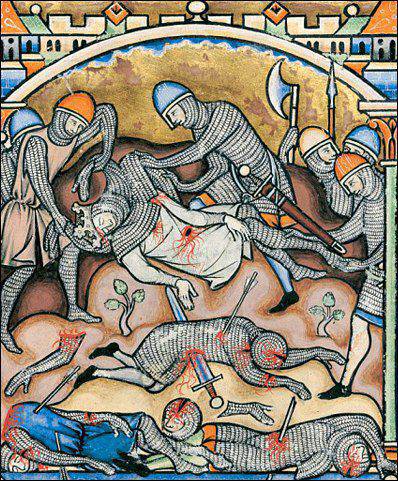
"The Philistines remove armor from Saul." Since the miniatures for this manuscript belonged to the same time as the "Ice Battle", it is difficult to argue that the knights "were chained in heavy armor." They then simply did not exist! Thumbnail from the Bible of Macieus. Pierpont Morgan Library and Museum, New York
Needless to say, patriotism is a good thing, and if necessary, it is patriotism that requires a citizen to die for the Motherland, but he does not demand to lie for her sake, because lying is the very last thing. And here we meet a real lie in the textbook for fourth-graders, and, alas, everything seems to be the way it should, because “knightly dogs” are “bad”. Yes, bad, yes, they are invaders, but why cheat children? They could not have lied, and the significance of the battle would not have diminished in the least!
By the way, they, before writing this, should have seen a very interesting article in the newspaper ... Pravda for 5 April 1942. Then there was the Great Patriotic War, the battle turned exactly 700 years, the Soviet press appealed to the glorious stories of our Motherland, Stalin himself suggested inspiring the memory of our glorious ancestors, but Pravda editorial (and you can imagine what the Pravda editorial did mean in those years ?!) there is not a word about sinking the knights in Lake Peipsi. That is, Stalinist propagandists understood the difference between the movie and ... the real story, but for some reason, today's authors of school textbooks do not!
Yes, but where did these knights sinking in the lake come from, clinging to ice floes and blowing bubbles? Did S. Eisenstein come up with all this? But no, it turns out that in the history of the confrontation of the Russian principalities of the expansion of the Teutonic Order to the East, there was such a battle in which the order riders actually fell through the ice, really was, only this happened ... much earlier than the “Ice Battle”!
The same ancient Russian chronicles tell us that in 1234, eight years before the “Ice Battle”, Prince Yaroslav Vsevolodovich from Pereyaslavl came with Nizovsky regiments and with Novgorod invaded the lands of the Order of the Swords, near the city of Yuriev, but did not besiege him. Knights left Yuriev, but were defeated in battle. Some of them immediately returned to the city, but the other, which was pursued by Russian warriors, fell on the ice of the Emaygi River. The ice fell, and these warriors drowned. In the history of this battle, the name “Battle on the Omovzhe” was named, and according to the German name of the river - “The Battle of Embach”. Well, the very content of the Novgorod chronicle looks like this: “Ida Prince Yaroslav on Nemtsy under Yuriev, and a hundred did not reach the city ... Prince Yaroslav bisha them ... on the river on Omizhezh Nemtsy broke off” (i.e. failed under the ice!) *
Obviously, in preparing for the shooting of the film, S. Eisenstein read all the Russian chronicles of this period, and received relevant comments from historians who explained to him what it means to "break the Germans." And the fact that the image of warriors drowning in the polynyas seemed to him dramatic in the highest degree and cinematographically very advantageous, can be considered undoubted. Here you can see, so to speak, the “hand of fate”. After all, it was not for nothing that Soviet newspapers at that time almost openly reported that even nature was on the side of Soviet working people and collective farmers. After all, "in Soviet Ukraine - a rich harvest, and in Western Ukraine - extreme crop failure" **. Here is only in the “Rhymed Chronicle” that the dead fell into the grass, but since there is no grass in April, we are talking about the thickets of dry reeds bordering the shores of the lake. That is, the Russian soldiers were on the shore, but the army of the order approached them on the ice of the lake. That is, the battle could not have been entirely on the ice, although the chronicles tell us that it was ice that was filled with blood!
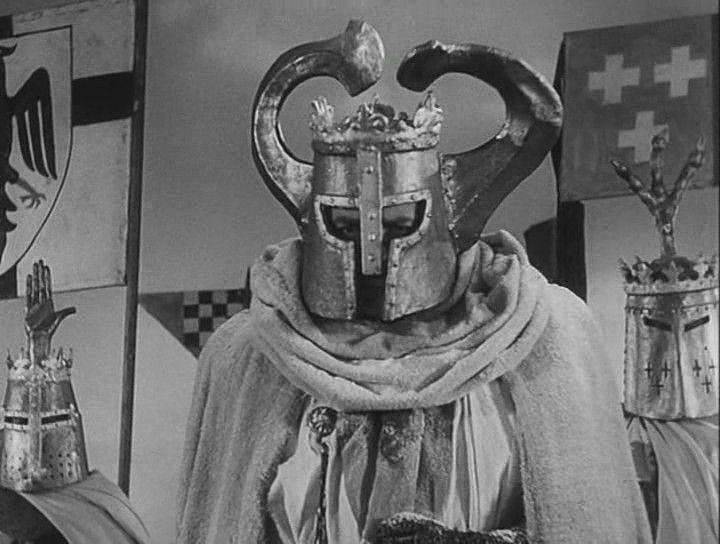
Knight-monk - "a warrior for the faith" (Christian), and suddenly - in a helmet with horns?
But the battle on the ice, though on the ice of the sea, in the history of the confrontation between the Slavs and the Teutonic Order was also, moreover, it could be called the “Ice Battle” with far greater reason.
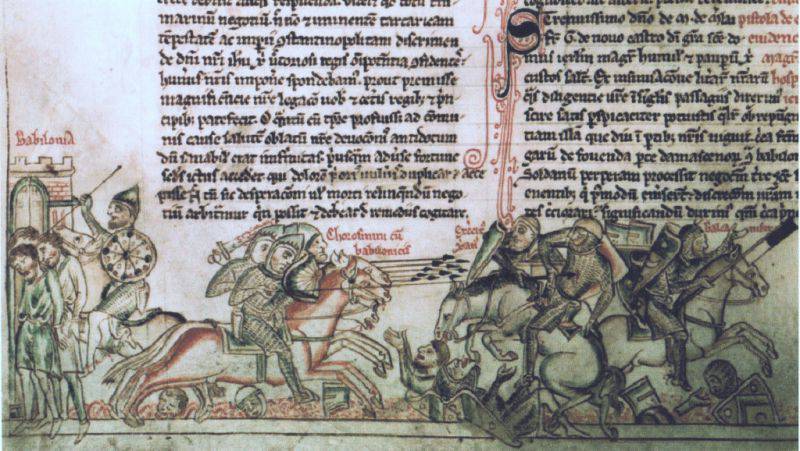
The Battle of Forbi, 1244. The Templars are defeated by the Muslims. Miniature from the "Big Chronicle" by Matthew Paris. Around 1250. Equipment of Crusaders and Muslims is clearly shown (British Library)
And it was like this that in 1268, the Novgorodians decided to go on a campaign against Lithuania, but they argued over whom to lead the campaign, which is why it never took place. But the Danish possessions were attacked, the Russians approached the Rakvere Castle (Rakovor), but they could not take it and asked Grand Prince Vladimir Yaroslav Yaroslavich for help. He sent his sons and other princes, and in Novgorod began collecting siege machines for the future assault on the city. Order bishops and knights from Riga, Viljandi and Yuriev arrived in Novgorod, asked for peace and promised that they would not help the peasants, but the oath (even on the cross), but this heretic, the knights, the oath was not considered. Therefore, their army soon left Yuriev, and, united with the Danes, rose up against the Russian troops on the left flank. The Danes were on the right flank, and in the center was the legendary German "pig." In the Novgorod Chronicle there is a story, which is not in the Chronicle, about the fierce battle of the Novgorodians with the “iron regiment” of the knights, in which the Novgorod mayor and the 13 boyars, tysyatsky, and the 2 boyar were also missing.
Meanwhile, the Russians managed to inflict a powerful counter-attack on the enemy. The Livonian Chronicle reports that 5000 warriors participated in it, but the knights managed to stop it. Our chronicle reports that the Russians won, and pursued the enemy running seven miles (seven everywhere, isn’t that so amazing ?!) up to Rakovor itself along three roads at once, since “horses could not walk on corpses”.
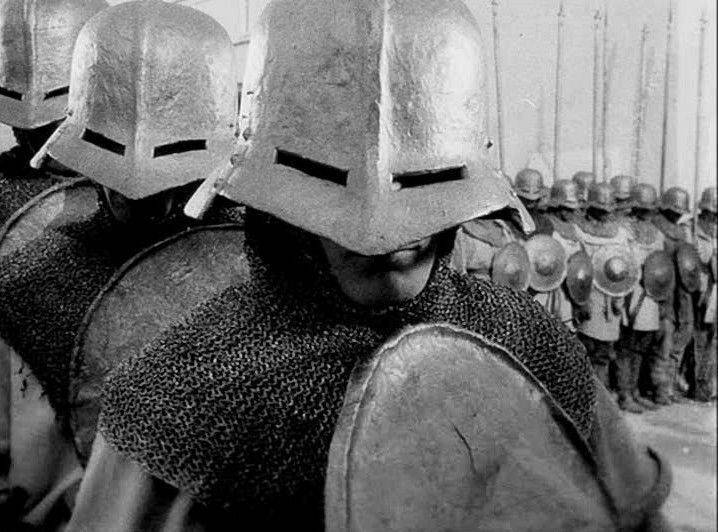
Typical helmets are sallet or salad, but, alas, not from that era.
By evening, a detachment of German soldiers came to the aid of the Germans, but only plundered the Novgorod wagon train. The Russians decided to wait for the morning to fight with them, but the Germans retreated in time. For three days the Russian troops stood at the walls of Rakovor, but they did not dare to storm the city. Meanwhile, the Pskov squad of Prince Dovmont invaded Livonia, destroying the ruins of the knights and capturing the prisoners. So he avenged them for previous attacks on the lands of his principality.
In 1269, the order troops launched a retreat, 10 days unsuccessfully besieged Pskov, but then retreated, learning that the Novgorod army was approaching the city with Prince Yury at the head. Both sides agreed on peace, because after this defeat, the orders could no longer threaten the stronger princedoms of North-Western Russia, and the Lithuanians in turn began to threaten him!
Lithuania in the Russian chronicles was first mentioned in the 1009 year, but only around the 1183 year merged into a single state. But even later, in the thirteenth century, both Lithuanians and Prussians continued to be pagans and did not want to be baptized. But for freedom it was necessary to pay and repel attacks both from the west and from the east. But the Lithuanians fought hard for their independence and the faith of their fathers, and were baptized only in 1367 year. In peacetime, they lived in farms and cattle breeding, but they had enough money to buy expensive iron ore. weapon. Often, Lithuanian riders also had large plots, which were partly leased out to personally free peasant communal peasants who fought in the infantry.
The army (karias) of the Lithuanians was tribal. Moreover, the saddle of the Lithuanian riders were more comfortable than the knight. In the summer they often made predatory raids for prey, but did not seize foreign lands. Fighting with them, the knights soon realized that fighting with such an enemy is best not in summer, but in winter, when rivers freeze and you can walk along them like on the way.
True, the Lithuanians skied like the Finns and fought on them! Men with such winter raids were usually killed, so as not to drive "full" in the snow. But women and children were taken with them, although because of them they had to go back slowly.
On one of these trips, the Lithuanians decided to go in the winter of 1270, on the day of the winter solstice. The Estonian Bishop Herman von Buckhovden, learned about the troops from Lithuania, and immediately sent the troops of Bishop Tartu, Danes from northern Estonia and a squad of knights of the Teutonic Order, led by Otto von Litterburg - Master of the Order in Livonia.
Ironically, the crusaders who marched to Lake Peipsi were also led by the Bishop of Tartu, also Herman, and also ... the uncle of this very von Buchkhoden. But the young Herman, apparently, did not know that he was being met by the army of the Grand Duke of Lithuania Treydenius, and that there were many Russian soldiers and veterans of past battles with the Crusaders, and they were all very determined.
16 February 1270 on the ice of the frozen Baltic Sea, the opposing forces met, and a hot battle ensued. The Lithuanians were surrounded by sleds, and their opponents lined up in three groups: the Teutonic Order's cavalry in the center, the bishop stood on the left flank, and the Danes on the right. It is known that the knights, who stood in the center, treated their allies with disdain and attacked the Lithuanians first, not waiting until all three detachments came out at the same time. Before the Danes approached them, the Lithuanians apparently crippled many horses, and the knights, without the support of infantry, could do nothing with them. Here the Lithuanians (most likely already with cavalry forces) began to surround the Livonian infantry and the surviving Teutonic knights. But here they came to the aid of the cavalry of the Danes and Bishop Herman. In the Livonian Rhymed Chronicle, this is written like this: “It was a wild horse killing and massacre on both sides, of Christians and pagans.
And the blood of people from both armies was spilled on the ice.
It was a fierce battle in which many human heads were chopped up.
The best (Master Otto) and 52 of good warrior monks are killed in the battle. ”
Christian sources report that the Crusaders lost six hundred people, and the Lithuanians - 1600! Therefore, the “battlefield”, if it can be said so about the surface of the frozen sea, was left for the knights, but their losses were so great that they felt the victory was not as complete as they would like. Here it should be noted that this battle helped the Lithuanians to gain national unity. But the Prussians on this path failed, and soon only one name remained of them.
Interestingly, it was David Nicole who wrote 20 years ago about Lithuanian military affairs of the 13th century. a very interesting article reporting a lot of interesting details. For example, the battles between the fighting detachments of the Lithuanian tribes usually took place in the form of a group duel. The warriors fought on foot, and in case of defeat they retreated to the horses, and sought refuge in flight. The main thing was to attack the enemy unexpectedly, throwing darts at a gallop and immediately retreating - these were the methods used by the Estonians, Lithuanians and Balts, and used saddles of a suitable device with a gentle back bow ***.
Their main weapon was a sword, mainly made in Germany, but the handle was locally made. Found handles made of iron and bronze with silver overlay ornaments. Moreover, metallographic analysis showed that the tips of spears and darts in Lithuania were imported from Scandinavia, but some were made by local blacksmiths. They were even made of Damascus steel. That is, the technology of welding damask was familiar to Lithuanian blacksmiths.
The main armor was chain mail, which was worn under warm outerwear and on top of it. Helmets - spheroconic, typical Eastern European. Shields - traditional, pan-European form. As for the famous "Lithuanian pavez" - that is, a shield with a hand chute in the middle, then the Lithuanians did not have it. The Lithuanians borrowed this shield from the north-eastern regions of Poland, where it became known in the middle of the 13th century. It should be emphasized that the Lithuanian cavalry played a very important role in the historic battle of Grunwald, when the military power of the Teutonic Order was very much undermined!
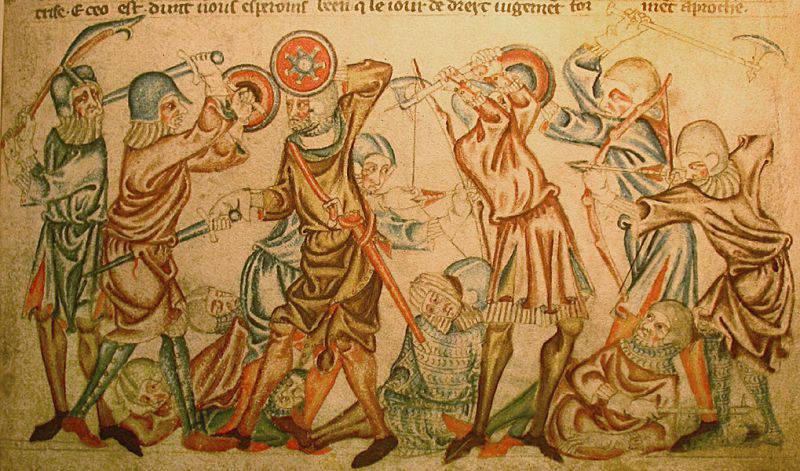
The battle scene from the Kholkhem hand-drawn Bible. Around 1326 - 1327
It shows the warriors with baklerah shields, the same as in the film "Alexander Nevsky", but the difference in time is almost 80 years.
So, most likely, the concept of the Alexander Nevsky movie by film director S. Eisenstein was based on the history of all these three battles in a revised and ideologically adjusted form. Well, his talent has done his job and as a result, his entire artistic fiction has been preserved even in 2014 school textbooks of the year! And, of course, very few people notice that from a historical point of view in this film there are many historical inconsistencies. Some of his characters are not dressed in the costumes that they should have been dressed in. The traitor Tverdilo it is not clear why he was dressed up in a cuirass, but they were not yet worn at that time. The slits on the helmets of the "knight-dogs" who had the shape of a cross are not really found. The T-shaped slit on the knight's helmets was, but in the shape of a cross - a clear author's invention. And Tophel helmets were assembled from 5 parts, and yet they weren't that much like buckets!
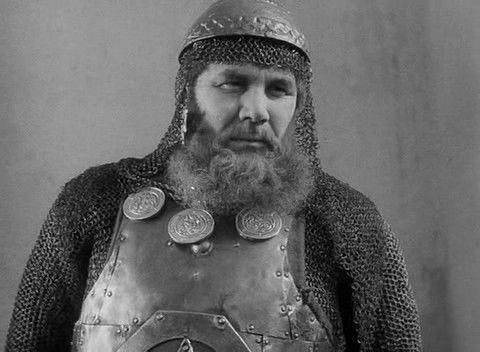
The traitor Tverdilo Ivankovich in mixed-type armor.
By the way, this film found its adepts even in other countries, national directors began to make historical films similar to it according to the plan. The second after “Alexander Nevsky” was the film “Kaloyan”, shot in Bulgaria in 1963 year. His plot is as follows: the Bulgarian Tsar Kaloyan fights with the Byzantines, the traitorous Bulgarians, and smashes the Western European crusaders, who have bucket-shaped helmets on their heads. Moreover, the events of this film refer to the 1205 year, when these helmets have not yet entered the military "fashion"! But, on what you will not go for the sake of a beautiful myth and an impressive frame? Therefore, the gilded "buckets" of the knights, and the solid-forged shell and helmet-bascinet on Tsar Kaloyan (appeared two centuries later) are such "trifles" that they do not even deserve attention!
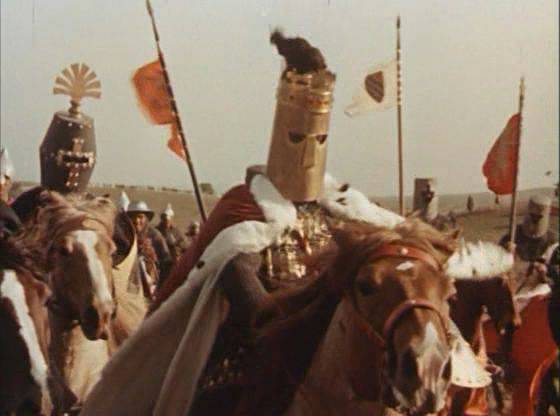
Quite a funny helmet on the knight-crusader 1205
It should be noted that the “knight dogs” of the Teutonic Order in Russia received their nickname only six centuries later and that was due to the incorrect translation of the works of Karl Marx into Russian. The founder of the communist teachings used in relation to these knights the noun "monk", which they were, but in German it turned out to be consonant with the word "dog"!
By the way, one should hardly attribute Alexander Nevsky and the phrase about the destruction of the enemies of the Russian land by the sword. That is, of course, he could well have said something like that — why not, but in reality this is a phrase from the Bible recalled by S. Eisenstein. And, again, from the point of view of art, the fact that he invented it very well, therefore, this is how the reading and education (“bookishness”) of the legendary prince is once more emphasized! Thus, there is not the slightest humiliation of our military glory in reading the chronicles and following the facts that are known to historical science today. Do not underestimate anything, but do not exaggerate anything!
* PSRL (Complete Russian Chronicles Collection), IV, 30, 178.
** Where the lords reign // True. 24 December 1937. No.352. C.5
*** Nicolle, D. Raiders of the Ice War. Medieval Warfar: e Teutonic Knights ambush Lithuanian Raiders // Military illustrated. Vol. 94. March. 1996. Pp 26 - 29.
Information